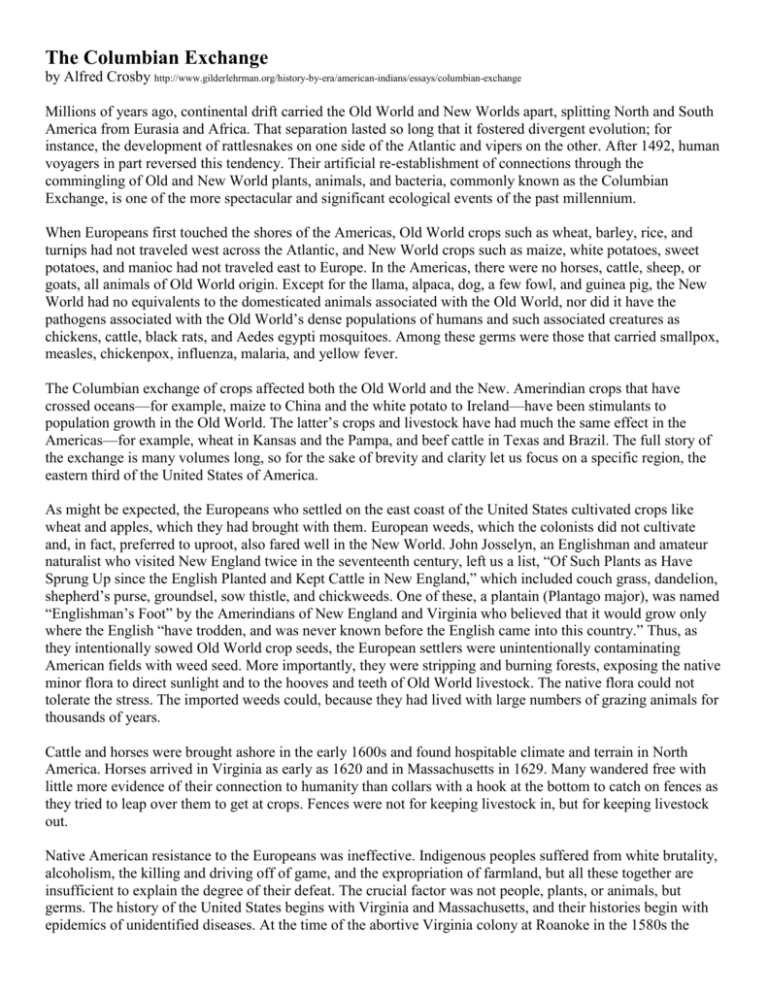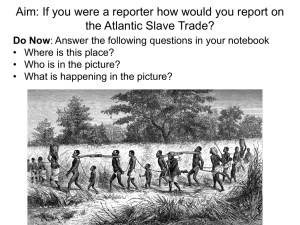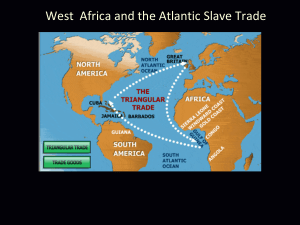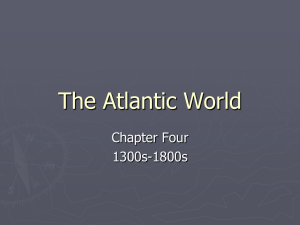The Columbian Exchange
advertisement

The Columbian Exchange by Alfred Crosby http://www.gilderlehrman.org/history-by-era/american-indians/essays/columbian-exchange Millions of years ago, continental drift carried the Old World and New Worlds apart, splitting North and South America from Eurasia and Africa. That separation lasted so long that it fostered divergent evolution; for instance, the development of rattlesnakes on one side of the Atlantic and vipers on the other. After 1492, human voyagers in part reversed this tendency. Their artificial re-establishment of connections through the commingling of Old and New World plants, animals, and bacteria, commonly known as the Columbian Exchange, is one of the more spectacular and significant ecological events of the past millennium. When Europeans first touched the shores of the Americas, Old World crops such as wheat, barley, rice, and turnips had not traveled west across the Atlantic, and New World crops such as maize, white potatoes, sweet potatoes, and manioc had not traveled east to Europe. In the Americas, there were no horses, cattle, sheep, or goats, all animals of Old World origin. Except for the llama, alpaca, dog, a few fowl, and guinea pig, the New World had no equivalents to the domesticated animals associated with the Old World, nor did it have the pathogens associated with the Old World’s dense populations of humans and such associated creatures as chickens, cattle, black rats, and Aedes egypti mosquitoes. Among these germs were those that carried smallpox, measles, chickenpox, influenza, malaria, and yellow fever. The Columbian exchange of crops affected both the Old World and the New. Amerindian crops that have crossed oceans—for example, maize to China and the white potato to Ireland—have been stimulants to population growth in the Old World. The latter’s crops and livestock have had much the same effect in the Americas—for example, wheat in Kansas and the Pampa, and beef cattle in Texas and Brazil. The full story of the exchange is many volumes long, so for the sake of brevity and clarity let us focus on a specific region, the eastern third of the United States of America. As might be expected, the Europeans who settled on the east coast of the United States cultivated crops like wheat and apples, which they had brought with them. European weeds, which the colonists did not cultivate and, in fact, preferred to uproot, also fared well in the New World. John Josselyn, an Englishman and amateur naturalist who visited New England twice in the seventeenth century, left us a list, “Of Such Plants as Have Sprung Up since the English Planted and Kept Cattle in New England,” which included couch grass, dandelion, shepherd’s purse, groundsel, sow thistle, and chickweeds. One of these, a plantain (Plantago major), was named “Englishman’s Foot” by the Amerindians of New England and Virginia who believed that it would grow only where the English “have trodden, and was never known before the English came into this country.” Thus, as they intentionally sowed Old World crop seeds, the European settlers were unintentionally contaminating American fields with weed seed. More importantly, they were stripping and burning forests, exposing the native minor flora to direct sunlight and to the hooves and teeth of Old World livestock. The native flora could not tolerate the stress. The imported weeds could, because they had lived with large numbers of grazing animals for thousands of years. Cattle and horses were brought ashore in the early 1600s and found hospitable climate and terrain in North America. Horses arrived in Virginia as early as 1620 and in Massachusetts in 1629. Many wandered free with little more evidence of their connection to humanity than collars with a hook at the bottom to catch on fences as they tried to leap over them to get at crops. Fences were not for keeping livestock in, but for keeping livestock out. Native American resistance to the Europeans was ineffective. Indigenous peoples suffered from white brutality, alcoholism, the killing and driving off of game, and the expropriation of farmland, but all these together are insufficient to explain the degree of their defeat. The crucial factor was not people, plants, or animals, but germs. The history of the United States begins with Virginia and Massachusetts, and their histories begin with epidemics of unidentified diseases. At the time of the abortive Virginia colony at Roanoke in the 1580s the nearby Amerindians “began to die quickly. The disease was so strange that they neither knew what it was, nor how to cure it.”[1] When the Pilgrims settled at Plymouth, Massachusetts, in 1620, they did so in a village and on a coast nearly cleared of Amerindians by a recent epidemic. Thousands had “died in a great plague not long since; and pity it was and is to see so many goodly fields, and so well seated, without man to dress and manure the same.”[2] Smallpox was the worst and the most spectacular of the infectious diseases mowing down the Native Americans. The first recorded pandemic of that disease in British North America detonated among the Algonquin of Massachusetts in the early 1630s: William Bradford of Plymouth Plantation wrote that the victims “fell down so generally of this disease as they were in the end not able to help one another, no not to make a fire nor fetch a little water to drink, nor any to bury the dead.”[3] The missionaries and the traders who ventured into the American interior told the same appalling story about smallpox and the indigenes. In 1738 alone the epidemic destroyed half the Cherokee; in 1759 nearly half the Catawbas; in the first years of the next century two-thirds of the Omahas and perhaps half the entire population between the Missouri River and New Mexico; in 1837–1838 nearly every last one of the Mandans and perhaps half the people of the high plains. European explorers encountered distinctively American illnesses such as Chagas Disease, but these did not have much effect on Old World populations. Venereal syphilis has also been called American, but that accusation is far from proven. Even if we add all the Old World deaths blamed on American diseases together, including those ascribed to syphilis, the total is insignificant compared to Native American losses to smallpox alone. The export of America’s native animals has not revolutionized Old World agriculture or ecosystems as the introduction of European animals to the New World did. America’s grey squirrels and muskrats and a few others have established themselves east of the Atlantic and west of the Pacific, but that has not made much of a difference. Some of America’s domesticated animals are raised in the Old World, but turkeys have not displaced chickens and geese, and guinea pigs have proved useful in laboratories, but have not usurped rabbits in the butcher shops. The New World’s great contribution to the Old is in crop plants. Maize, white potatoes, sweet potatoes, various squashes, chiles, and manioc have become essentials in the diets of hundreds of millions of Europeans, Africans, and Asians. Their influence on Old World peoples, like that of wheat and rice on New World peoples, goes far to explain the global population explosion of the past three centuries. The Columbian Exchange has been an indispensable factor in that demographic explosion. All this had nothing to do with superiority or inferiority of biosystems in any absolute sense. It has to do with environmental contrasts. Amerindians were accustomed to living in one particular kind of environment, Europeans and Africans in another. When the Old World peoples came to America, they brought with them all their plants, animals, and germs, creating a kind of environment to which they were already adapted, and so they increased in number. Amerindians had not adapted to European germs, and so initially their numbers plunged. That decline has reversed in our time as Amerindian populations have adapted to the Old World’s environmental influence, but the demographic triumph of the invaders, which was the most spectacular feature of the Old World’s invasion of the New, still stands. [1] David B. Quinn, ed. The Roanoke Voyages, 1584–1590: Documents to Illustrate the English Voyages to North America (London: Hakluyt Society, 1955), 378. [2] Edward Winslow, Nathaniel Morton, William Bradford, and Thomas Prince, New England’s Memorial (Cambridge: Allan and Farnham, 1855), 362. [3] William Bradford, Of Plymouth Plantation, 1620–1647, ed. Samuel E. Morison (New York: Knopf, 1952), 271. Initial European Slave Economy Source: http://exploringafrica.matrix.msu.edu/students/curriculum/m7b/activity1.php As you know from earlier studies of American history, slavery remains a crucial area of study in the history of North America. Over the course of more than 400 years, historians estimate that more than 15 million Africans were forced to leave Africa to cross the Atlantic to be sold into slavery. In addition, millions of other Africans lost their lives during slave raids or during their forced removal to coastal forts where they would be transported to the Americas. As a result of the Atlantic Slave Trade, most people of African descent in North and South America today can account for their families' passage from Africa to the Americas through the Atlantic Slave Trade. How did the Atlantic Slave Trade begin, how did it operate, and what was its impact on the African continent? The Beginnings of the Atlantic Slave Trade Europeans had been involved in trade with Africa since before the Atlantic Slave Trade began. There was extensive trade in gold and salt across the Sahara Desert; Europeans had become involved in this trade and developed a strong demand for gold in their economy. However, Europeans were dependent on “middle-men” who would bring gold from the Kingdoms of West Africa across the Sahara Desert. In the 1400s, Prince Henry of Portugal began an initiative to seek out direct sea routes to gain access to the gold trade in West Africa, as well as trade in Asia. In the fifteenth century, European countries were seeking trade routes with Asia, particularly the spice islands of south-east Asia. Just as Spain sponsored Christopher Columbus in his attempt to find a sea route to Asia by sailing to the west, so Prince Henry and the Portuguese hoped to find a sea route to Asia by sailing around the coast of Africa. The first slaves brought to Portugal came in 1444 from Northern Mauritania. From Mauritania, the Portuguese moved their way down the western coast of Africa, establishing contact all the way down to the Cape of Good Hope and around to the other side of Africa. Portugal was the first of a number of European nations who became involved in the Atlantic Slave Trade. As an example of what transpired through this period of Portuguese exploration, we will briefly look at the Kongo (Congo) Kingdom. Remember that this is one of many examples— interaction of European powers and Africans varied from region to region. In this example, you will see that what may have seemed like a diplomatic exchange of citizens in the beginning grew into a system of slave trade that devastated the Kongo Kingdom. In 1483, the Portuguese began a long-term relationship with the Kongo Kingdom (see map below to locate the Kongo Kingdom.) Portuguese explorers sailed the Atlantic Ocean down into the mouth of the Congo River. Upon reaching the Kongo Kingdom, they took Kongo emissaries back to Portugal, then later returned to Africa with European soldiers, priests, and goods. This was the beginning of a strong trade relationship with the Kongo that exported slaves and ivory in exchange for European luxury goods and guns. Although historians know that slavery existed in some places on the African continent prior to the Atlantic Slave Trade, the ways in which African slavery compared to and interacted with the exportation of African slaves across the Atlantic remains a topic of much discussion and debate. The nature and extent of slavery in Africa before the Atlantic Slave Trade is difficult to know. Many historians suggest that slavery as practiced in different areas in Africa was not the same as “chattel slavery”-seeing human beings as mere property-which was practiced in the Americas. For example, slaves in some West African societies filled different positions in society, including positions of important responsibility; they were not restricted to hard labor. However, it is not easily determined to what extent the Atlantic Slave Trade fueled and even transformed the practice of slavery within Africa. Certainly this varied from region to region, and there are many regions within Africa where slavery was not even practiced. There is no doubt that the Atlantic Slave Trade brought dramatic changes on a global scale throughout the African continent as well as the Americas. In the case of the Kongo Kingdom, a form of slavery existed prior to Portuguese contact, which the Portuguese tapped into. However, the Portuguese had a dramatic impact on the Kongo Kingdom through pressure to increase raids of neighboring peoples to capture for the Atlantic Slave Trade and the exportation of large numbers of Kongolese over many years. The Atlantic Slave Trade fueled violence in the region, removed productive workers from the Kongo, and encouraged an economy built around slavery. Over time, the Kongo Kingdom became weaker and more dependent on Portuguese assistance.






